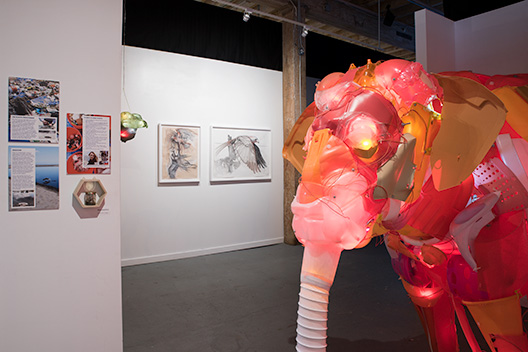
360º, MUSEUM, VIRTUAL TOUR,
EDUCATION
THE ANIMAL MUSEUM, CRAZY AS A CAT LADY
The requirements were threefold. First, the artifacts themselves required photography. Second, the museum space needed documentation. This was done formally, with direct photography of the exhibits, informally during an event, and very specifically to provide an image for an article in The Washington Post.
Thirdly, the museum would be documented for perpetuity through the making of a 360º virtual tour. This tour would include not only visual documentation of the overall spaces, but it would have working access to the exhibits through embedded video and text-based pop-up information panels.
Crazy Cat Lady and a lot more...

The inaugural exhibition of The Animal Museum entitled, "Crazy Cat Lady", was featured in the Washington Post. It's a popular trope and added a vein of humor to a topic, animal welfare, that is often quite sad. It was a challenge to do justice to the main exhibit in a single image in as much as it invited being physically present to step inside the living room and have a truly immersive moment.
 The next two exhibitions, "Entangled" and "Fashion Tails", had a
diverse range of media with mixed lighting methods. The
trick was to capture multiple exposures and create a composite
image for each scene. For example, in the original photo of the
elephant, the hanging bird beyond was overexposed.
The next two exhibitions, "Entangled" and "Fashion Tails", had a
diverse range of media with mixed lighting methods. The
trick was to capture multiple exposures and create a composite
image for each scene. For example, in the original photo of the
elephant, the hanging bird beyond was overexposed.
 The fishing nets exhibit presented yet another situation with
mixed media types. In the photography of the exhibit, it was
necessary to take several photos to capture a suitable
screen on each computer monitor for use in a final composite
image. For the virtual tour, however, links to the actual videos
were added to the monitor displays as hotspots...
touching/clicking on those hotspots initiated the associated
video for online viewing. Additionally, hotspots were added to
the informational placards, to present them enlarged for
reading.
The fishing nets exhibit presented yet another situation with
mixed media types. In the photography of the exhibit, it was
necessary to take several photos to capture a suitable
screen on each computer monitor for use in a final composite
image. For the virtual tour, however, links to the actual videos
were added to the monitor displays as hotspots...
touching/clicking on those hotspots initiated the associated
video for online viewing. Additionally, hotspots were added to
the informational placards, to present them enlarged for
reading.Building the tour
A critical aspect of any 360º virtual tour is wayfinding. To help the visitor navigate purposefully through a tour there must be not only a path forward, but ideally a combination of paths so that choices are apparent. Additionally, thumbnails that transport the visitor to specific locations add to efficiency, especially for repeat visits or users looking to scan a tour quickly.
Takeaways
The three exhibitions of The Animal Museum provided a variety of content with a range of photographic challenges. From the photography of artifacts to a 360º virtual immersive tour, each category of presentation added to a larger presence for a humble yet earnest museum.Exhibitions exist for a time, and then make way for the next ones. Photographic and informational documentation can preserve a meaningful snapshot of those productions. A 360º virtual tour is especially valuable and provides a strong sense of the original environment. It is a dynamic legacy for an event that was important, yet inevitably temporary.